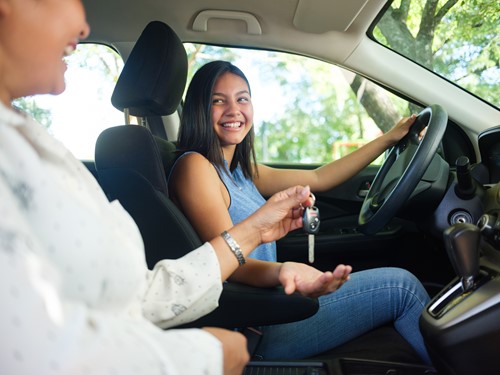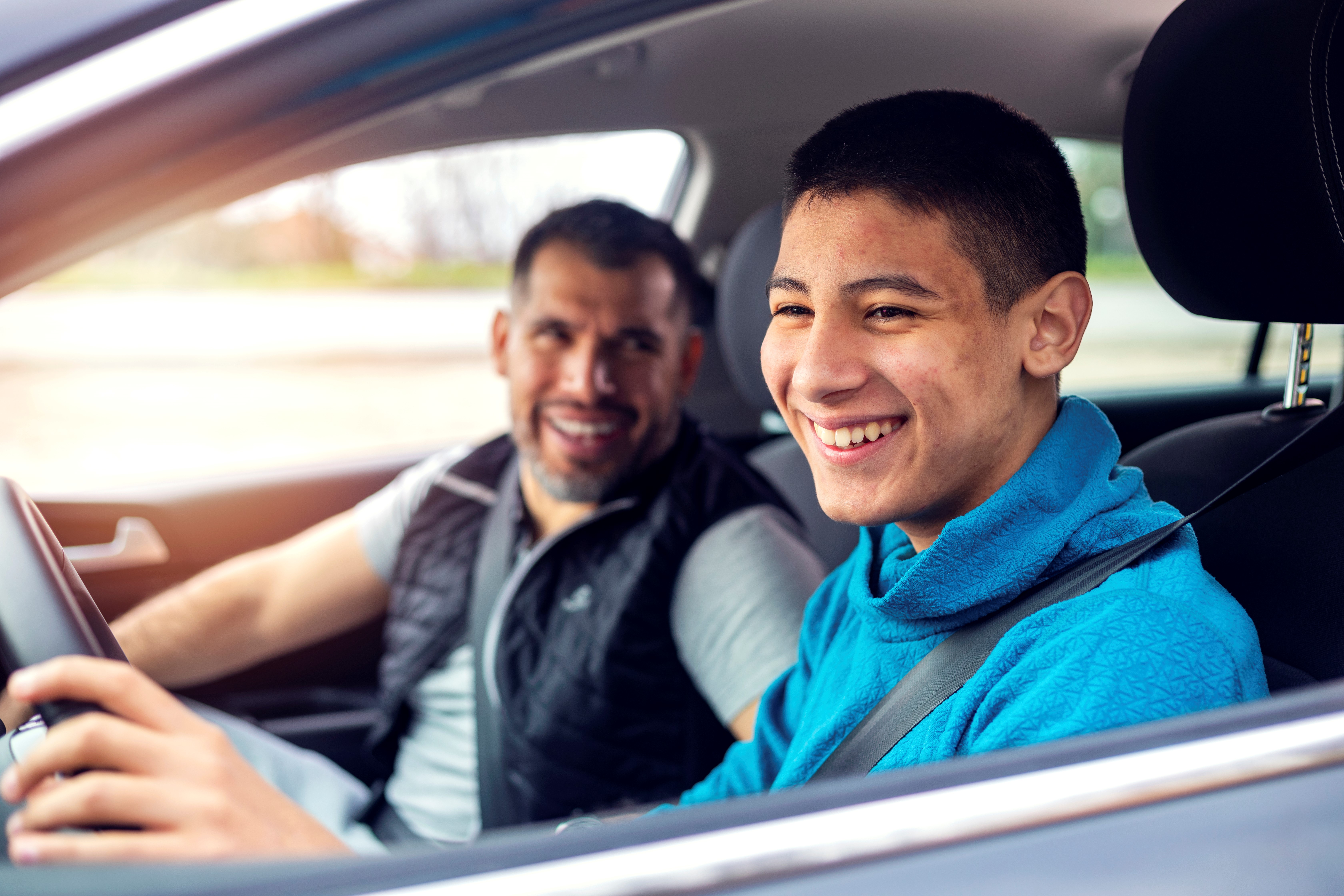
Teen Driving
5/2/2022
TEEN DRIVING
Learning to drive is a right of passage. Most people learn to drive while a teenager or young adult. Age limits and rules around driving are determined by the state you live in. Teaching your child to drive is a scary parenting milestone. Learning about teen driving, the risks of teens driving, and how to set boundaries and limits around driving to keep your teen safe will help you through this milestone.
Teen Driving Statistics
Accidents are the leading cause of death among teenagers with traffic accidents accounting for almost 75% of accidental deaths. Over 5,500 young people die in accidents every year and even more are injured.
Teens are three times more likely to be in an accident than drivers over the age of 20. Why is this? Teen brains are still developing. They are more likely to be in an accident for the following reasons:
- Poor motor coordination
- Poor judgment
- Lack of experience
- More likely to miscalculate a situation
- More likely to be distracted
- More likely to make critical errors
- Overestimating their skill or ability.
Most crashes occur in the first 6 months of unsupervised driving. Besides inexperience, other factors that increase risk of accidents with teen drivers are the time of day, the season, passengers, and substance use which will be discussed below.
Role of Parents
Parental involvement in teaching your child to drive and setting rules around driving can cut the risk of traffic accidents by half. How do we help keep our children safe?
Modeling Behavior
Model behavior safe behavior in the car by
- Wearing your seatbelt
- Don’t drink or use drugs then drive
- Don’t text while driving
- Do not drive distracted
- Don’t speed
- Obey all traffic laws
Know the Law
It is also important to know the driving laws in your state as well as what limits or restrictions your state may put on your teen. You also must know your legal responsibility when teaching your teen to drive or allowing your teen to drive unsupervised.
Many states have graduated licensing programs aimed at helping prevent distracted driving and accidents. For example, in Massachusetts, teens under 18 must take driver’s education class before applying for a learner’s permit and passing the permit exam. Before starting on the road, the parent is required to take a 2 hour driving course. The teen can’t apply for their license until they have had their permit for 6 months while maintaining a clean driving record. They must log 12 hours practice driving and 6 hours observation with a driving school as well as 40 hours driving with a parent.
Once you have your license, for the first 6 months you are prohibited from having passengers if you are under 18 unless they meet certain criteria. They must be a person aged 18 or older, with over a year of driving experience, who has an active driver's license, and who sits in the passenger seat. This does not include siblings. A teen cannot drive between 12:30am to 5am until they are 18 years old.
In New Hampshire, teens can start driving at 15.5 years and can apply for a license at age 16 after completing drivers education. They must have 40 hours of driving practice with their parent in the car including 10 hours of night driving. Once they have their license, they cannot drive between 1am and 4am until they are 18 years old. They can only have one passenger younger than 25 years old in the car for the first 6 month in which they hold their license.
Setting Rules
Setting strict rules around driving is imperative to helping your child drive safely. As your child gains experience and your trust, these rules can be loosened or modified. The AAP has a great Teen-Parent driving contract that can help establish rules and consequences. You can find that HERE.
Teaching your Child to Drive
The more experience your child has, the safer they will be as a driver. Some states have requirements as to how many hours of practice a teen must have before they can become a licensed driver. Some require 30-50 hours of practice with parents on top of the required hours with a driver education program. You want to give your child lots of opportunity to practice. Practice should include
- Different skills
- Different routes
- Different types of roads: back roads, divided highways, undivided highways etc
- Different times of day
- Different types of weather
- All types of traffic
- Exposure to hazards such as pedestrians and bikers
Before embarking on a lesson, discuss the skills and road situations you may encounter before the lesson begins. Start slowly and work through the stages of driving education.
- Learn about the vehicle
- How to put on the seatbelt
- How to add and check fuel
- How to deal with an accident
- How to turn the car on and off
- How to work the windshield wipers
- What various lights mean and how they work
- Learn basic driving skills
- Back up the car
- Make safe turns-right and left including signaling
- Show awareness of surroundings
- Stop the car smoothly
- Interact with other drivers and distractions
- Operate around parked cars
- Operate around other drivers
- Operate around pedestrians
- Change lanes
- Navigate through an intersection
- Use mirrors and check blind spots
- Park and Turn
- 3 point turns
- U turns
- Parking on a hill
- Parallel parking
- Pulling in and out of a parking spot
- Advance Skills
- Driving at night
- Driving in ice, snow, and wet weather
- Driving on the highway
Make sure to use an even and calm tone of voice when teaching your child. If your child makes a mistake, talk through it calmly and discuss how to approach a similar situation in the future. Make a log with your recorded hours and skills practiced to refer back to as needed.

Safe Vehicle
Some teens will drive their family car. Some teens may want to work towards purchasing a car of their own. Small, cheap cars may not be the best option for your teen. Larger cars offer more crash protection though very large SUVs can have higher roll-ability so choosing mid-size car or SUV is the safest choice for teens. Newer cars also provide more technology aimed at keeping drivers safe. Technology, including electronic stability control, rear vision cameras, automatic braking, blind spot detection, and lane maintenance alerts help keep drivers safe. Additionally, some cars have teen-specific driver technology. This technology helps limit or block electronic distractions.
Distracted Driving
Distracted driving causes over 60% of all teen accidents. There are 3 types of distraction. Visual distraction is when a driver looks away from the road. Manual distraction is when a driver is doing something that takes a hand or hands off the wheel. Mental distraction is when a driver is thinking of something other than driving.
Most teen accidents due to distraction are the result combination of the three types of distractions and includes interacting with passengers, interacting with technology (texting or using cell phone), looking at something inside or outside the vehicle, singing or dancing, grooming or applying makeup, or reaching for something.
Passengers
Passengers in the car increase the risk of a crash. Having another passenger increases the risk of a crash by 40%, 2 passengers doubles the risk, and 3 passengers quadruples the risk. There is an additional 15% increase risk during the summer months attributed to teens driving with friends.

Texting and Driving
Despite being illegal in many states, 82% of teens have texted while driving with 33% admitting to regularly texting while driving. And 77% believe they can safely drive and text! A teen increases the risk of having an accident by 23 times if they are texting while driving. Even a quick text, just 5 seconds, is dangerous. When driving, 5 seconds doesn’t seem like much but the distance traveled can be as long as a football field!
Texting is not the only phone-based distraction. Over 40% of teens admit to emailing while driving! Talking on the phone is also a distraction. Talking on the phone increases the risk of a crash by 6 times!

Night Driving
Night driving increases the risk of crashes with more crashes happening between 9pm to 12 am than any other time. Night driving only accounts for 25% of all driving but over 50% of all accidents. This can be due to limited visibility, fatigue, or encountering drunk or drugged drivers.
Drowsy Driving
Drowsy driving is driving while fatigued. Being fatigued while driving affects alertness, attention, reaction time, and judgment. Teens who get less than 6 hours of sleep or teens who drive from 12am-6am are at higher risk for accidents than well-rested teens driving during the day.
Driving Drunk or Intoxicated
Driving while drunk or intoxicated is risky for any driver but more so for teens who are at higher risk for injury and death than adults at equivalent blood alcohol levels. Drugs and alcohol impair judgment, slow reaction times, and result in poor decision making skills.
Teen drivers are 17 times more likely to die in a crash when they have been drinking and 60% of all fatal car accidents where a teen dies are due to drugs or drinking. Almost 10% of all teens admit to driving after drinking and 25% of teens admit to being a passenger in a car of someone who was drunk driving. This rate has steadily decreased over time but we can reduce this number even further with parental involvement, graduated driver licensing programs, and zero tolerance laws.
ADHD and Driving
What if your child has ADHD or has issues with focusing and being distracted? Children with ADHD need special attention and consideration when learning to drive because they are at higher risk for distracted driving. Teens with ADHD have a 36% higher risk of an accident than their peers. ADHD symptoms, including difficulties with executive function, poor judgment, increased risk taking or thrill seeking, inattention, distraction and impulsivity, increase the risk of distracted driving. Distracted driving puts ADHD teens on par with that of someone who is driving while intoxicated.
Studies that look at teen drivers with ADHD shows where teens struggling when driving. Teens with ADHD self report that they
- Have more accidents
- Have more rear end collisions
- Receive more traffic citations
- Engage in reckless or risky driving
- Have more road anger or rage
Driving simulation tests shows that teens with ADHD have
- More collisions or crashes
- Engage in speeding more frequently
- Scrape the car more frequently
- Poor steering control
- Increased swerving in lanes
- Slower reaction times
- More driving errors
- More fatigued driving
On the road tests show that teens with ADHD
- Have more collisions
- Have more crashes
- Speed more
- Make more driving errors
- Brake hard more often
- Make more sudden decelerations
- Weave more
Before your teen with ADHD starts driving, you and your child should discuss driving with their primary care provider or medication provider. Your child needs to know they have a neurological condition that increases the risk of unsafe driving. Discuss medications that may help your child stay focused and less distracted while driving. ADHD stimulant-based medication has been shown to improve the ability of the teen to pay attention while driving and follow traffic laws. Stimulant-based medications reduce the rate of car accidents versus unmedicated peers. The ADHD Safe Driving Program, a program designed by Russell Barkley and Daniel Cox at CHADD (Children and Adults with Attention Deficit/Hyperactivity Disorder), can help parents navigate this milestone.
RESOURCES
For more resources for all teen drivers, please check out the following links:
Teen Driving: Driving Stuff for Rookies
Mass.gov: Tips for Teen Drivers
National Safety Council: Tips for Teen Drivers
National Highway Traffic Safety Administration: Teen Driving
Coming a new driver is an important milestone and step towards adulthood and independence for your teen. By setting a good example, taking time to teach and allow your child to practice, as well as set strict rules and consequences, we can help our children stay safe as they take to the roads.
Children’s Health Care of Newburyport, Massachusetts and Haverhill, Massachusetts is a pediatric healthcare practice providing care for families across the North Shore, Merrimack Valley, southern New Hampshire, and the Seacoast regions. The Children’s Health Care team includes pediatricians and pediatric nurse practitioners who provide comprehensive pediatric health care for children, including newborns, toddlers, school aged children, adolescents, and young adults. Our child-centered and family-focused approach covers preventative and urgent care, immunizations, and specialist referrals. Our services include an on-site pediatric nutritionist, special needs care coordinator, and social workers. We also have walk-in appointments available at all of our locations for acute sick visits. Please visit chcmass.com where you will find information about our pediatric doctors, nurse practitioners, as well as our hours and services.
Disclaimer: this health information is for educational purposes only. You, the reader, assume full responsibility for how you choose to use it.










